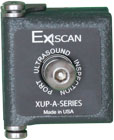Ultrasound Ports From Exiscan: See More Safely™
![]()
Ultrasound Ports allow workers to gather Ultrasound Data from energized equipment while keeping panels and doors closed, in compliance OSHA, NFPA 70E, CSA Z462 requirements. Closed-panel inspection through an Exiscan™ XU port is easier, safer, and far more efficient than opening enclosures.
|
|
Why Ultrasound Ports?
|

